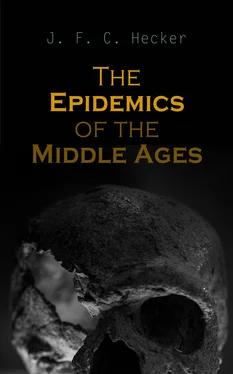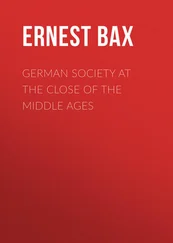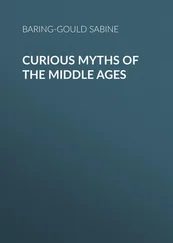1 ...6 7 8 10 11 12 ...22 In the progress of connected natural phenomena, from East to West, that great law of nature is plainly revealed which has so often and evidently manifested itself in the earth’s organism, as well as in the state of nations dependent upon it. In the inmost depths of the globe, that impulse was given in the year 1333, which in uninterrupted succession for six-and-twenty years shook the surface of the earth, even to the western shores of Europe. From the very beginning the air partook of the terrestrial concussion, atmospherical waters overflowed the land, or its plants and animals perished under the scorching heat. The insect tribe was wonderfully called into life, as if animated beings were destined to complete the destruction which astral and telluric powers had begun. Thus did this dreadful work of nature advance from year to year; it was a progressive infection of the Zones, which exerted a powerful influence both above and beneath the surface of the earth; and after having been perceptible in slighter indications, at the commencement of the terrestrial commotions in China, convulsed the whole earth.
The nature of the first plague in China is unknown. We have no certain intelligence of the disease, until it entered the western countries of Asia. Here it shewed itself as the oriental plague with inflammation of the lungs; in which form it probably also may have begun in China, that is to say, as a malady which spreads, more than any other, by contagion—a contagion, that, in ordinary pestilences, requires immediate contact, and only under unfavourable circumstances of rare occurrence is communicated by the mere approach to the sick. The share which this cause had in the spreading of the plague over the whole earth, was certainly very great: and the opinion that the Black Death might have been excluded from Western Europe, by good regulations, similar to those which are now in use, would have all the support of modern experience, provided it could be proved that this plague had been actually imported from the East; or that the oriental plague in general, whenever it appears in Europe, has its origin in Asia or Egypt. Such a proof, however, can by no means be produced so as to enforce conviction; for it would involve the impossible assumption, either that there is no essential difference between the degree of civilization of the European nations, in the most ancient and in modern times, or that detrimental circumstances, which have yielded only to the civilization of human society and the regular cultivation of countries, could not formerly keep up the glandular plague.
The plague was, however, known in Europe before nations were united by the bonds of commerce and social intercourse 51; hence there is ground for supposing that it sprung up spontaneously, in consequence of the rude manner of living and the uncultivated state of the earth; influences which peculiarly favour the origin of severe diseases. Now, we need not go back to the earlier centuries, for the 14th itself, before it had half expired, was visited by five or six pestilences 52.
If, therefore, we consider the peculiar property of the plague, that, in countries which it has once visited, it remains for a long time in a milder form, and that the epidemic influences of 1342, when it had appeared for the last time, were particularly favourable to its unperceived continuance, till 1348, we come to the notion, that in this eventful year also, the germs of plague existed in Southern Europe, which might be vivified by atmospherical deteriorations; and that thus, at least in part, the Black Plague may have originated in Europe itself. The corruption of the atmosphere came from the East; but the disease itself came not upon the wings of the wind, but was only excited and increased by the atmosphere where it had previously existed.
This source of the Black Plague was not, however, the only one; for, far more powerful than the excitement of the latent elements of the plague by atmospheric influences, was the effect of the contagion communicated from one people to another, on the great roads, and in the harbours of the Mediterranean. From China, the route of the caravans lay to the north of the Caspian Sea, through Central Asia, to Tauris. Here ships were ready to take the produce of the East to Constantinople, the capital of commerce, and the medium of connexion between Asia, Europe and Africa 53. Other caravans went from India to Asia Minor, and touched at the cities south of the Caspian Sea, and lastly from Bagdad, through Arabia to Egypt; also the maritime communication on the Red Sea, from India to Arabia and Egypt, was not inconsiderable. In all these directions contagion made its way; and doubtless, Constantinople and the harbours of Asia Minor, are to be regarded as the foci of infection; whence it radiated to the most distant seaports and islands.
To Constantinople, the plague had been brought from the northern coast of the Black Sea 54, after it had depopulated the countries between those routes of commerce; and appeared as early as 1347, in Cyprus, Sicily, Marseilles and some of the seaports of Italy. The remaining islands of the Mediterranean, particularly Sardinia, Corsica and Majorca, were visited in succession. Foci of contagion existed also in full activity along the whole southern coast of Europe; when, in January 1348, the plague appeared in Avignon 55, and in other cities in the south of France and north of Italy, as well as in Spain.
The precise days of its eruption in the individual towns, are no longer to be ascertained; but it was not simultaneous; for in Florence, the disease appeared in the beginning of April 56; in Cesena, the 1st of June 57; and place after place was attacked throughout the whole year; so that the plague, after it had passed through the whole of France and Germany, where, however, it did not make its ravages until the following year, did not break out till August, in England; where it advanced so gradually, that a period of three months elapsed before it reached London 58. The northern kingdoms were attacked by it in 1349. Sweden, indeed, not until November of that year: almost two years after its eruption in Avignon 59. Poland received the plague in 1349, probably from Germany 60, if not from the northern countries; but in Russia, it did not make its appearance until 1351, more than three years after it had broken out in Constantinople. Instead of advancing in a north-westerly direction from Tauris and from the Caspian Sea, it had thus made the great circuit of the Black Sea, by way of Constantinople, Southern and Central Europe, England, the northern kingdoms and Poland, before it reached the Russian territories; a phenomenon which has not again occurred with respect to more recent pestilences originating in Asia.
Whether any difference existed between the indigenous plague, excited by the influence of the atmosphere, and that which was imported by contagion, can no longer be ascertained from facts; for the contemporaries, who in general were not competent to make accurate researches of this kind, have left no data on the subject. A milder and a more malignant form certainly existed, and the former was not always derived from the latter, as is to be supposed from this circumstance—that the spitting of blood, the infallible diagnostic of the latter, on the first breaking out of the plague, is not similarly mentioned in all the reports; and it is therefore probable, that the milder form belonged to the native plague,—the more malignant, to that introduced by contagion. Contagion was, however, in itself, only one of many causes which gave rise to the Black Plague.
This disease was a consequence of violent commotions in the earth’s organism—if any disease of cosmical origin can be so considered. One spring set a thousand others in motion for the annihilation of living beings, transient or permanent, of mediate or immediate effect. The most powerful of all was contagion; for in the most distant countries which had scarcely yet heard the echo of the first concussion, the people fell a sacrifice to organic poison,—the untimely offspring of vital energies thrown into violent commotion.
Читать дальше










